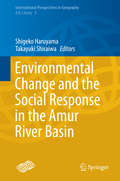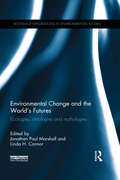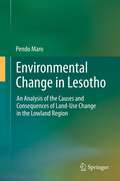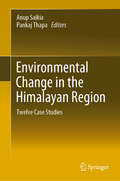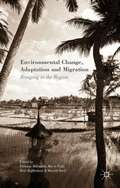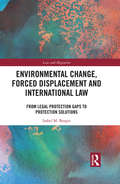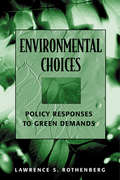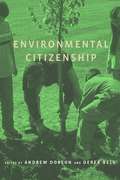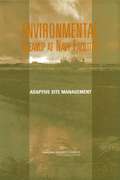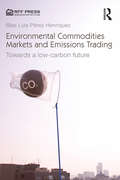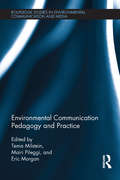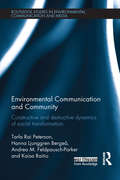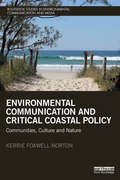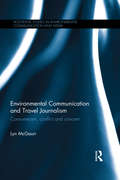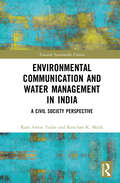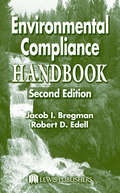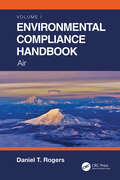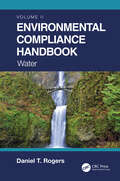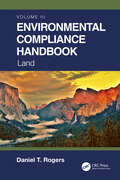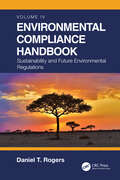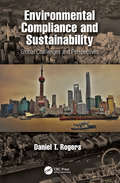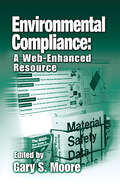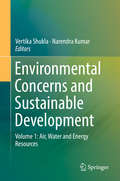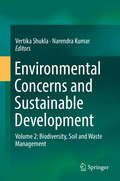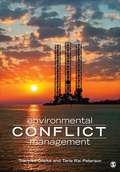- Table View
- List View
Environmental Change and the Social Response in the Amur River Basin
by Takayuki Shiraiwa Shigeko HaruyamaThis book features research on historical land use and land cover in the Amur River Basin, which are important not only for residents there but also for those affected by its material and water cycles. Land use and land cover are affected by natural and human interactions over long and short timescales. The authors address historical changes in the land cover analysis of the Amur. The Amur region of Russia, land cover change analysis of the Amur, wetland, and flooding of the Amur provide evidence of land cover change. Changes of wetland and floodplain sedimentation processes demonstrate the influences of land cover change on fluvial environment, which are discussed with geomorphology. Water chemistry is showing the physical dimension of the geography of the Amur. The development process of timber harvesting in the Khabarovsk area and land use dynamics in the twentieth century are important evidence of development. The Amur poses an essential question: how can we manage a transboundary watershed without disturbing terrestrial and marine ecosystems for future generations? This book provides essential information for geographers about this relatively unknown region.
Environmental Change and the World's Futures: Ecologies, ontologies and mythologies (Routledge Explorations in Environmental Studies)
by Jonathan Paul Marshall and Linda H. ConnorClimate change and ecological instability have the potential to disrupt human societies and their futures. Cultural, social and ethical life in all societies is directed towards a future that can never be observed, and never be directly acted upon, and yet is always interacting with us. Thinking and acting towards the future involves efforts of imagination that are linked to our sense of being in the world and the ecological pressures we experience. The three key ideas of this book – ecologies, ontologies and mythologies – help us understand the ways people in many different societies attempt to predict and shape their futures. Each chapter places a different emphasis on the linked domains of environmental change, embodied experience, myth and fantasy, politics, technology and intellectual reflection, in relation to imagined futures. The diverse geographic scope of the chapters includes rural Nepal, the islands of the Pacific Ocean, Sweden, coastal Scotland, North America, and remote, rural and urban Australia. This book will appeal to researchers and students in anthropology, sociology, environmental studies, cultural studies, psychology and politics.
Environmental Change in Lesotho
by Pendo MaroEnvironmental Change in Lesotho identifies and analyzes the drivers of land-use change and the consequences of these changes on the livelihoods of rural land-users/managers. To accomplish this, a combination of tools from the social sciences and environmental fields were developed to identify causes and consequences of land-use change at selected levels, using a 'nested' approach. These methods were then applied to a case study of two villages in the Lowland region of Lesotho. This book is directed at environmental and social science experts, researchers, decision-makers, and development/aid workers interested in understanding the intricate human-environment relationship as it relates to land-use change in a changing biophysical, socio-economic, political and institutional context, coupled by HIV/AIDS, changing demographics, local perceptions and what is termed here 'dependency syndrome'.
Environmental Change in the Himalayan Region: Twelve Case Studies
by Anup Saikia Pankaj ThapaThe book focuses on environment and conservation issues pertaining to the Himalayas, spanning Pakistan, Nepal, India, Bhutan and Myanmar. Environmental degradation, changes in snow cover and glaciers in India-Bhutan, threats to protected areas, and biodiversity in this ecologically fragile region are assessed in twelve distinct, regional case studies.
Environmental Change, Adaptation and Migration: Bringing In The Region
by Felicitas HillmannThe contributors present empirical and theoretical insights on current debates on environmental change, adaptation and migration. While focusing on countries subject to environmental degradation, it calls for a regional perspective that recognises local actors and a systematic link between development studies and migration research.
Environmental Change, Forced Displacement and International Law: from legal protection gaps to protection solutions (Law and Migration)
by Isabel M. BorgesThis book explores the increasing concern over the extent to which those suffering from forced cross-border displacement as a result of environmental change are protected under international human rights law. Formally they are not entitled to admission or stay in a third state country, a situation that has been identified as an international "legal protection gap". The book seeks to provide answers to two basic questions: whether and to what extent existing international law protects cross-border environmental displacement, and whether and how existing formalized regional complementary protection standards can interpretively solidify and conceptualize protection for cross-border environmental displacement. The discussion outlines that the protection of the human person is not only an ex post facto obligation of states, but must be increasingly seen as an ex ante one. The analysis further suggests that the European Union regionally orientated protection regime can help states to consolidate an evolving protection paradigm of proactive and reactive measures being erected at the international level. It can also narrow the identified legal protection gaps. In so doing, it helps states to reconceptualise protection as a holistic and dynamic enterprise. This book will be of great interest to academics in law, political science and human rights, policy makers and civil society organisations both at national and international level.
Environmental Choices: Policy Responses to Green Demands
by Lawrence S. RothenbergWithin a federal system, government agencies and regulatory policies can be fractured -- even at odds with each other. National actors share power with their counterparts in states and localities, as do presidents with Congressional leaders, and bureaucrats with judges. Understanding the broad economic and political contexts of environmental policymaking illuminates the motivations behind policy choices of various interested parties, from the National Park Service and the EPA to environmental activists and members of Congress. Rothenberg utilizes basic economic ideas to provide, not only a fresh look at how the U.S. deals with environmental ills, but a way of thinking about policy making in general.
Environmental Citizenship
by Andrew Dobson Derek BellThis book considers the theory and practice of environmental citizenship, the obstacles to its realization, and the opportunities it presents for bringing about environmental and social sustainability.
Environmental Cleanup at Navy Facilities: Adaptive Site Management
by Committee on Environmental Remediation at Naval FacilitiesThe number of hazardous waste sites across the United States has grown to approximately 217,000, with billions of cubic yards of soil, sediment, and groundwater plumes requiring remediation. Sites contaminated with recalcitrant contaminants or with complex hydrogeological features have proved to be a significant challenge to cleanup on every level—technologically, financially, legally, and sociopolitically. Like many federal agencies, the Navy is a responsible party with a large liability in hazardous waste sites. Environmental Cleanup at Navy Facilitites applies the concepts of adaptive management to complex, high-risk hazardous waste sites that are typical of the military, EPA, and other responsible parties. The report suggests ways to make forward progress at sites with recalcitrant contamination that have stalled prior to meeting cleanup goals. This encompasses more rigorous data collection and analysis, consideration of alternative treatment technologies, and comprehensive long-term stewardship.
Environmental Commodities Markets and Emissions Trading: Towards a Low-Carbon Future
by Blas Luis Pérez HenríquezMarket-based solutions to environmental problems offer great promise, but require complex public policies that take into account the many institutional factors necessary for the market to work and that guard against the social forces that can derail good public policies. Using insights about markets from the new institutional economics, this book sheds light on the institutional history of the emissions trading concept as it has evolved across different contexts. It makes accessible the policy design and practical implementation aspects of a key tool for fighting climate change: emissions trading systems (ETS) for environmental control. Blas Luis Pérez Henríquez analyzes past market-based environmental programs to extract lessons for the future of ETS. He follows the development of the emissions trading concept as it evolved in the United States and was later applied in the multinational European Emissions Trading System and in sub-national programs in the United States such as the Regional Greenhouse Gas Initiative (RGGI) and California’s ETS. This ex-post evaluation of an ETS as it evolves in real time in the real world provides a valuable supplement to what is already known from theoretical arguments and simulation studies about the advantages and disadvantages of the market strategy. Political cycles and political debate over the use of markets for environmental control make any form of climate policy extremely contentious. Pérez Henríquez argues that, despite ideological disagreements, the ETS approach, or, more popularly, 'cap-and-trade' policy design, remains the best hope for a cost-effective policy to reduce GHG emissions around the world.
Environmental Communication Pedagogy and Practice (Routledge Studies in Environmental Communication and Media)
by Tema Milstein Mairi Pileggi Eric L MorganGiven the urgency of environmental problems, how we communicate about our ecological relations is crucial. Environmental Communication Pedagogy and Practice is concerned with ways to help learners effectively navigate and consciously contribute to the communication shaping our environmental present and future. The book brings together international educators working from a variety of perspectives to engage both theory and application. Contributors address how pedagogy can stimulate ecological wakefulness, support diverse and praxis-based ways of learning, and nurture environmental change agents. Additionally, the volume responds to a practical need to increase teaching effectiveness of environmental communication across disciplines by offering a repertoire of useful learning activities and assignments. Altogether, it provides an impetus for reflection upon and enhancement of our own practice as environmental educators, practitioners, and students. Environmental Communication Pedagogy and Practice is an essential resource for those working in environmental communication, environmental and sustainability studies, environmental journalism, environmental planning and management, environmental sciences, media studies and cultural studies, as well as communication subfields such as rhetoric, conflict and mediation, and intercultural. The volume is also a valuable resource for environmental communication professionals working with communities and governmental and non-governmental environmental organisations.
Environmental Communication and Community: Constructive and destructive dynamics of social transformation (Routledge Studies in Environmental Communication and Media)
by Tarla Rai Peterson, Hanna Ljunggren Bergeå, Andrea M. Feldpausch-Parker and Kaisa RaitioAs society has become increasingly aware of environmental issues, the challenge of structuring public participation opportunities that strengthen democracy, while promoting more sustainable communities has become crucial for many natural resource agencies, industries, interest groups and publics. The processes of negotiating between the often disparate values held by these diverse groups, and formulating and implementing policies that enable people to fulfil goals associated with these values, can strengthen communities as well as tear them apart. This book provides a critical examination of the role communication plays in social transition, through both construction and destruction of community. The authors examine the processes and practices put in play when people who may or may not have previously seen themselves as interconnected, communicate with each other, often in situations where they are competing for the same resources. Drawing upon a diverse selection of case-studies on the American, Asian and European continents, the chapters chart a range of approaches to environmental communication, including symbolic construction, modes of organising and agonistic politics of communication. This volume will be of great interest to researchers, teachers, and practitioners of environmental communication, environmental conflict, community development and natural resource management.
Environmental Communication and Critical Coastal Policy: Communities, Culture and Nature (Routledge Studies in Environmental Communication and Media)
by Kerrie Foxwell-NortonThe vast majority of the world’s population lives on or near the coast. These communities are an extraordinary and largely untapped resource that can be used to mitigate planetary disaster and foster environmental stewardship. Repeated waves of scientific fact and information are not inciting action, nor apparently producing enough momentum to change voting behaviour towards a progressive environmental politics. A critical coastal policy, underpinned by a deeper understanding of environmental communication, can offer something new to this status quo. Environmental Communication and Critical Coastal Policy argues that more science and ‘better’ communication has been largely responsible for the lacklustre response by citizens to environmental challenges. Foxwell-Norton asserts that the inclusion of a range of local meanings and cultural frameworks with which experts could engage would better incite participation in, and awareness of, local environmental issues. The value and possible role of ‘geo-community media’ (mainstream, alternative and social media) is examined here to illustrate and support the key argument that meaningful local engagement is a powerful tool in coastal management processes. This is a valuable resource for postgraduates, researchers and academics across environmental science and management, policy studies, communication studies and cultural studies.
Environmental Communication and Travel Journalism: Consumerism, Conflict and Concern (Routledge Studies in Environmental Communication and Media)
by Lyn McGaurrTravel journalism about natural attractions is environmental communication at the cusp of consumerism and concern. Countries and regions that market forests, rivers and wildlife to international tourists drive place-of-origin brand recognition that benefits exporters in other sectors. Place-branding in such destinations is not just PR for environmentally sustainable development and consumption, but also a political enterprise. Environmental Communication and Travel Journalism considers tourism public relations as elite reputation management, and applies models of political conflict and source-media relations to the analysis of the ‘soft’ genre of travel journalism. The book seeks to understand how, in whose interests and against what odds discourses of cosmopolitanism and place-branding influence the way travel journalists represent vulnerable and contested environments. Informed by interviews with journalists and their sources, Environmental Communication and Travel Journalism identifies and theorises networks, cultures, discursive strategies and multiple loyalties that can assist or interrupt flows of environmental concern in the cosmopolitan public sphere. The book should be of interest to scholars of environmental communication, environmental politics, journalism, tourism, marketing and public relations.
Environmental Communication and Water Management in India: A Civil Society Perspective (Towards Sustainable Futures)
by Kanchan K. Malik Ram Awtar YadavThis book analyses the underlying communication strategies and approaches of grassroots water management practices in India through a case study-based ethnographic approach. Drawing from fieldwork experiences, this volume provides a detailed overview of Parmarth, a not-for-profit NGO, which is the case study for this research. It presents an in-depth theoretically informed analysis of data collected through multiple methods, which includes key informant interviews, focus group discussions, participant observation, and document reviews, among other approaches. The book examines Parmarth’s strategies and processes to mobilise women as important stakeholders in the region’s water conservation initiatives. It discusses communicative actions, tactics and campaigns in water interventions and the role of various stakeholders ranging from local community members to civil society. Accessibly written, this volume is a must-read for scholars and researchers of media and communication studies, environmental communication, ecology studies, development studies, public policy, sustainable development, water management, sociology, and political science.
Environmental Compliance Handbook
by Jacob I. Bregman Robert D. EdellIf your organization was subject to the thousands of federal, state, and local environmental laws and regulations in effect in the U.S. at the turn of the century, the Environmental Compliance Handbook should be within easy reach. Thousands of professionals have benefited from the bestselling classic. This practical, comprehensive book simplifies t
Environmental Compliance Handbook, Volume 1: Air
by Daniel T. RogersEnvironmental laws and regulations are extremely complex and difficult to understand. In order to comply with them, they need to be explained in layperson’s terms. This handbook identifies many changes in regulations and recommends ways to apply and implement them. Containing the latest environmental information, this volume addresses environmental compliance with air and provides a historical perspective to help follow the logical growth and increased complexity of air regulations through time. Structured as a “step-by-step how-to” book, readers will find real-life examples for the most important aspects of language, permit terms, demonstrating compliance, and organization for air projects. Features: Identifies all air pollution control regulations and the requirements of any air pollution control permits available up to date. Answers in depth all practical questions that arise when working on compliance projects in a “how to” method. Addresses a wider spectrum of issues that go beyond chemical-based contamination and environmental regulations and examines the impacts of climate change Includes many real-life examples from industry and institutions that comply with air quality regulations and air pollution control permits It is global in coverage and very useful to companies that have expanded operations outside their country of origin.
Environmental Compliance Handbook, Volume 2: Water
by Daniel T. RogersEnvironmental laws and regulations are extremely complex and difficult to understand. In order to comply with them, they need to be explained in layperson’s terms. This handbook identifies many changes in regulations and recommends ways to apply and implement them. Containing the latest environmental information, this volume addresses environmental compliance with water and provides a historical perspective to help follow the logical growth and increased complexity of water regulations through time. Structured as a “step-by-step how-to” book, readers will find real-life examples for the most important aspects of language, permit terms, demonstrating compliance, and organization for water projects. Features: Identifies all water pollution control regulations and the requirements of any water pollution control permits available up to date Answers in depth all practical questions that arise when working on compliance projects in a "how-to" method Addresses a wider spectrum of issues that go beyond chemical-based contamination and environmental regulations and examines the impacts of climate change Includes many real-life examples and case studies from industry and institutions that comply with water quality regulations It is global in coverage and very useful to companies that have expanded operations outside their country of origin
Environmental Compliance Handbook, Volume 3: Land
by Daniel T. RogersEnvironmental laws and regulations are extremely complex and difficult to understand. In order to comply with them, they need to be explained in layperson’s terms. The handbook identifies many changes in regulations and recommends ways to apply and implement them. Containing the latest environmental information, this third volume addresses environmental compliance with land and provides a historical perspective to help follow the logical growth and increased complexity of land regulations through time. Structured as a “step-by-step how-to” book, readers will find real-life examples for the most important aspects of language, permit terms, demonstrating compliance, and organization for land projects. Features: Introduces all land pollution control regulations and the requirements of any land pollution control permits available up to date Answers in depth all practical questions that arise when working on compliance projects in a "how-to" method Addresses a wider spectrum of issues that go beyond chemical-based contamination and environmental regulations and examines the impacts of climate change Includes many real-life examples and case studies from industry and institutions that comply with land use regulations It is global in coverage and very useful to companies that have expanded operations outside their country of origin
Environmental Compliance Handbook, Volume 4: Sustainability and Future Environmental Regulations
by Daniel T. RogersEnvironmental laws and regulations are extremely complex and difficult to understand. In order to comply with them, they need to be explained in layperson’s terms. This handbook identifies many changes in regulations and recommends ways to apply and implement them. Containing the latest environmental information, this volume goes beyond environmental regulations in two fundamental aspects: sustainability and preparation for future requirements before mandates are enacted. Structured as a “step-by-step how-to” book, readers will find real-life examples for the most important aspects of evaluating sustainability initiatives and preparing for new and revised environmental regulations. Features: Explores all sustainability related concepts and regulations and the requirement of any control permits available up to date. Answers in depth all practical questions that arise when working on compliance projects for future requirements. Addresses a wider spectrum of sustainability issues that go beyond chemical-based contamination and environmental regulations and examines the impacts of climate change. Includes many real-life examples and case studies from industry and institutions that comply with sustainability regulations. It is global in coverage and very useful to companies that plan to expand operations outside their country and are interested in future regulations.
Environmental Compliance and Sustainability: Global Challenges and Perspectives
by Daniel T. RogersThis book provides a critical understanding of the challenges that exist in protecting the local and global environment through compliance efforts using existing environmental regulations. The best compliance measures with the most useful regulations from over 50 countries are surveyed and are combined with science-based quantitative analysis of geology, hydrogeology, and the chemistry of contaminants from anthropogenic sources. The results are presented as a model that establishes a means by which protection of the environment can be greatly improved. This is accomplished through a deeper understanding of our natural world and how anthropogenic activities and their management affect our planet. Features The first book that examines the successes of environmental regulation worldwide and highlights the areas that need improvement Presents a tested and verified scientific model for enhanced environmental protection with scalability from local parcels to global levels Describes and integrates the importance of understanding the geologic and hydrogeologic environment of urban and developed areas Explains the importance of understanding the different types of pollution and their behavior in the environment Identifies the need for consistency in banning chemicals that are harmful in not just one country but throughout the world
Environmental Compliance: A Web-Enhanced Resource
by Gary S. MooreSTAY INFORMED-STAY COMPLIANT-STAY UP-TO-DATEYou can't do business in the United States without complying with a whole new generation of environmental regulations. Get all the information you need with Environmental Compliance: A Web-Enhanced Resource. This resource will never be outdated. With the continually updated Web site, you will alwa
Environmental Concerns and Sustainable Development: Volume 1: Air, Water and Energy Resources
by Narendra Kumar Vertika ShuklaThe prevailing global environmental crisis is primarily because of non-standardized parameters for environmental regulation. Unplanned expansion of economic activities, consideration for environmental conservation and several associated problems are emerging due to degradation in quality of ambient environment such as clean air, safe drinking water and quality of food, particularly in developing nations. Due to poor/casual execution of EIA protocol, newly developing countries are preferred destination for establishing pollution emitting industries, which results in degradation and depletion of natural resources. Lack of environmental policy intervention is another major attraction for establishing such industries in these nations. In order to ensure sustainable development, the highest priority issues include the monitoring and eradication of environmental problems which arise due to economic development. Initiation of any form of economic development primarily results in loss of forests and thus biodiversity, followed by deterioration in quality of air and contamination of natural resources. The worst impact of non-standardized economic development is the contamination of air, water and soil. Sustainable development ensures responsible interface with the environment to minimize the depletion or degradation of natural resources and ensure long term environmental quality. It involves integrated approaches in understanding the importance of environmental management systems and policy inventions leading to improved environmental performance. The present book is proposed to address the environmental concerns associated with economic development and approaches involved to attain sustainable economic development, which include monitoring of the quality of air, deforestation, quality of water resources, soil erosion and degradation of the natural environment.
Environmental Concerns and Sustainable Development: Volume 2: Biodiversity, Soil and Waste Management
by Narendra Kumar Vertika ShuklaThe current global environmental crisis is primarily the result of non-standardized parameters for environmental regulation, and is impacting e.g. clean air, safe drinking water and the quality of food, particularly in developing nations. Due to their poor/lax execution of EIA protocols, newly developing countries are preferred destinations for establishing pollution-emitting industries, which results in the degradation and depletion of their natural resources. Lack of environmental policy intervention is another major incentive to base “dirty” industries in these nations. In order to ensure sustainable development, the highest-priority issues include the monitoring and eradication of environmental problems stemming from economic development; virtually every form of economic development primarily results in the loss of forests and thus biodiversity, followed by declining air quality and the contamination of natural resources. Sustainable development ensures responsible interactions with the environment, so as to minimize the depletion or degradation of natural resources and preserve environmental quality. It involves integrated approaches to understanding the importance of environmental management systems and policy measures that lead to improved environmental performance. This book addresses the environmental concerns associated with economic development, and with approaches to attaining sustainable economic development, which include monitoring the quality of water resources, soil erosion and degradation of the natural environment.
Environmental Conflict Management
by Tarla Rai Peterson Tracy Lee ClarkeA step-by-step guide connecting theory to practice Environmental Conflict Management introduces students to the research and practice of environmental conflict and provides a step-by-step process for engaging stakeholders and other interested parties in the management of environmental disputes. In each chapter, authors Dr. Tracylee Clarke and Dr. Tarla Rai Peterson first introduce a specific concept or process step and then provide exercises, worksheets, role-plays, and brief case studies so students can directly apply what they are learning. The appendix includes six additional extended case studies for further analysis. In addition to providing practical steps for understanding and managing conflict, the text identifies the most relevant laws and policies to help students make more informed decisions. Students will develop techniques for public involvement and community outreach, strategies for effective meeting management, approaches to negotiating options and methodologies for communicating concerns and working through differences, and outlines for implementing and evaluating strategies for sustaining positive community relations.
